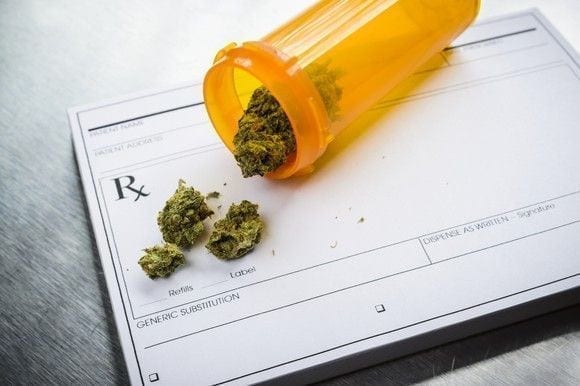Legal
These 20 States Haven’t Legalized Medical Marijuana, but That May Soon Change
The legal cannabis industry is budding before our eyes. In just under three months, thanks to the passage of the Cannabis Act by our neighbor to the north, adults will be able to legally purchase recreational marijuana. In fact, when the green flag officially waves on Oct. 17, it’ll allow Canada to become the first industrialized nation in the world to allow the sale of adult-use cannabis.
We’ve also witnessed big changes to the south, with Mexico giving the green light to medical cannabis in June 2017. Globally, more than two dozen countries have passed broad-based legislation allowing physicians to prescribe medical weed to patients.
Despite being federally illegal, 30 states have passed broad-based medical weed laws
But in the United States, we have a murky mess. At the federal level, marijuana is still an entirely illicit drug that’s deemed highly prone to abuse and has no recognized medical benefits. Yet, in spite of this Schedule I classification according to the Controlled Substances Act, 30 states — the newest of which is the red-leaning Oklahoma — and Washington, D.C., have passed sweeping medical marijuana laws since 1996.
It’s certainly not hard to understand why we’ve seen such a push to legalize medical pot, either. An April 2018 survey from the independent Quinnipiac University found that an overwhelming 93% of respondents favored the idea of allowing a physician to prescribe medical marijuana. Interestingly enough, this strong support also included seniors and Republicans, which happen to be the two groups who consistently have a mixed or negative view of marijuana.
We also have the recent approval of GW Pharmaceuticals‘ (NASDAQ: GWPH) Epidiolex to thank. GW Pharmaceuticals’ lead drug is cannabidiol (CBD)-based, (the non-psychoactive component of cannabis known for its medical benefits. In late-stage trials that led to its approval by the Food and Drug Administration, Epidiolex handily met its primary endpoint of reducing seizure frequency from baseline and relative to a placebo in two rare types of childhood-onset epilepsy. In effect, GW Pharmaceuticals offered the first real example in the U.S. of cannabis delivering a medical benefit.
These 20 states have said no to medical marijuana, but that may soon change
Yet in spite of this momentum, 20 states have held firm on their view that marijuana (recreational or medical) is an illegal substance. These states are:
Data source: ProCon.org. Table by author.
Now, to be fair, 16 of the 20 states where medical cannabis is still illegal do allow for CBD use for select ailments. The four states that completely ban recreational and medical cannabis, along with CBD in any form, are Idaho, Kansas, Nebraska, and South Dakota. If we were to pick out the most anti-marijuana states in the U.S., these four would likely take the cake.
But, truth be told, the number of states to have legalized medical cannabis has crept up in recent years, and 2018 could be another year where the remaining holdouts shrink further.

For example, residents in the traditionally conservative state of Utah will be voting on Proposition 2 this coming November, which would legalize medical marijuana for qualifying illnesses. Though Proposition 2 would ban smoking marijuana, it would allow an individual with a medical card to purchase up to two ounces of unprocessed marijuana or up to 10 grams of CBD or tetrahydrocannabinol (THC), the psychoactive component of cannabis that gets you “high,” over a two-week period. In five separate polls since February 2017, support for legalizing medical marijuana in Utah has ranged between 69% and 78%, presumably putting this measure on track for passage this fall.
One of the aforementioned strictest states, Nebraska, could find pro-cannabis groups making a push to legalize by 2020. Though legislation that would have amended the Nebraska state constitution to legalize medical weed was introduced this year, the Nebraska State Senate didn’t allow it to come to vote. However, a survey from the Lincoln Journal Star in February 2017 found that a whopping 77% of residents favored the idea of legalizing medical marijuana.
Two dynamics that could swing the pot pendulum
Clearly, the legal cannabis landscape is evolving in the U.S., but it’s going to take one or two catalysts to really elicit any opportunity for change.
The first catalyst would be a shift in the make-up of Congress. Currently, Republicans control the legislative branch, albeit by a small margin in the Senate. If Democrats were to gain control of the Senate and/or House, they might be able to introduce a medical cannabis bill that would pass muster. As a reminder, Democrats have a considerably more favorable view of cannabis (recreational and medical) than Republicans. It’s unclear at this point if President Trump would sign such legislation if it reached his desk, but he did suggest on the campaign trail in 2016 that he was “100 percent” behind medical marijuana.
The second dynamic here that could lead to real reform is the evolution of public perception. The aforementioned Quinnipiac poll from April also asked respondents whether they could vote for a candidate if that candidate didn’t share their view on cannabis but did on other issues. A whopping 82% said “yes,” suggesting that marijuana isn’t exactly a game-changing political issue as of yet. But if cannabis does become more of a polarizing topic with the American public, elected officials would have to worry about losing their seat if they didn’t go along with the consensus opinion.
Momentum certainly appears to be pushing toward eventual reform at the federal level. But, as has been the case for many years now, putting your hard-earned money to work in the U.S. cannabis industry simply isn’t a prudent move until after that change has occurred. Your best bet for the time being is to watch and wait from the safety of the sidelines.




